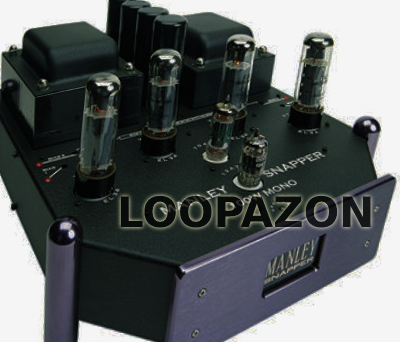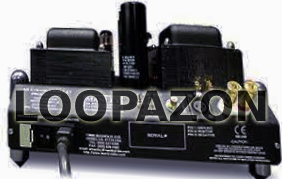An introduction to the Manley SNAPPER Power Amplifier
Form a band online, promote your music, buy custom beats, sound parts, and share your Beat or Track as a Royalty Free loop with us. Collaborate to make beats online with the best loop makers from around the world on the Forum for musicians and beat makers. Keep up to date with Music News and learn from FL Studio Video Tutorials and the articles on the Blog. Free DAW Music Software downloads, VST and Instrument Packs for FL Studio, Pro Tools, Logic, Ableton, and how to use the most popular free DAW Software, Fruity Loop Plugins, MIDIs and more.
An introduction to the Manley SNAPPER Power Amplifier
The Snapper got introduced in 2002, a very delectable all-tube 100-watt monoblock. Mitch Margolis' Snapper utilizes a quartet of EL34 or 6CA7 transistors in a completely differential circuit layout, including the input and driving stages. The XLR input on Manley Snapper is driven fully balanced. If the preamplifier has balanced outputs, this amplifier is the first Manley design to utilize your XLRs without the use of extra balancing input circuitry or input transformers. The unbalanced RCA's can be used instead of balanced RCA's in this particular topology with similarly excellent results.
Manley
Labs' monoblock amplifier is as unique as the company itself. This
company, which is owned and run by a woman, is an outlier in an
industry. The company workers are mostly men whose hardworking reap a
great production and success in the majority. Manley Labs is owned by
EveAnna Manley. Like other designers and manufacturing engineers, she
is also one among them. The main purpose of Manley is to make your
recordings sound professional. Many A-list recording studios
throughout the globe use their tube-based microphone preamps,
limiters, equalizers, line preamps, D/A converters, and power
amplifiers. For Manley, Home theatre is neither the first nor second
interest, Manley, like Genelec, M&K, Bryston, and ATC- all of
whom specialize in professional recording gear—does, however,
provide specific components that can utilize in a high-end home
cinema. This is the case with their new Snapper monoblock amplifier.

The Snapper features four EL34 power tubes, each of which generates a certain amount of heat, although the amp's structure allows for adequate ventilation. Even though the Snapper, like other tube amplifiers, requires periodic biassing of its power tubes, the technique is so easy that it can be done in minutes.
Although it's rectangular, two of its front corners have been sheared off to create a shortened plane on the front face. A lighted, 114 by 212-inch panel reads Manley snapper on the metallic-blue faceplate. A 1-inch-thick metallic-blue dowel serves as a spiked foot on each of the Snapper's corners, lifting the unit's bottom plate by nearly 112 inches. The dowels not only help with ventilation but they also help to break up the cabinet's straight edges. Setting the upper part of the Snapper's back panel at a 45° angle to make the inputs and outputs easier to connect was another excellent touch. The Snapper is 39 pounds in weight.
Six tubes make up the Snapper's basic yet complex circuit. The input tube is a 12AT7, with the voltage driver being a 7044. The output power is provided by four EL34 tubes working in ultra-linear mode. The complete amplifier is designed using a fully balanced differential topology, which is typical in solid-state amplifiers but uncommon in tube amplifiers. The negative speaker terminal is not the same as the positive output terminal. When compared to a traditional tube amplifier, this differential circuit enhances linearity. Manley Labs creates its own audio transformers, and the Snapper has a brand-new 19-section output transformer. Four 1300F, 350VDC computer-grade capacitors store 180 joules of energy for the B+ rail in the power supply.

The Snapper monoblock from Manley Labs delivers the most incredible sonic features of tube-based power amplifiers into the home theatre at a price comparable to top-tier solid-state amps. Without compromising sweetness or slam, the Manley Snappers offer the finesse and midrange layering to reward deep absorption into complex soundscapes on the one hand and unadorned vocals on the other. The Snappers are a pair of monoblock tube amps that are both strong and quiet. They're sung in a way that sounds as beautiful and clear as rainfall while still packing a powerful dramatic impact. Together, these amps generate beautiful music. They're robust, tuneful, optimistic, and energetic, with just the proper amount of lushness and fluidity to create a sophisticated, emotionally engaging sound.
Many
subtle and overt modifications in the SNAPPER's circuitry enable
uncolored and revealing melodic replication of the input signal. The
all-balanced and self-balancing conveyance of this musical signal via
the amplifier, from input jacks and speaker terminals, is paramount.
This method helps to eliminate the undesired interaction between the
audio signals passing through a particular amplifier stage and the
power supply energy biassing that stage. The input and driver stages
are rock-steady stabilized as a consequence of this method, and their
performance is unaffected by signal dynamics or power supply voltage
changes. Even though the signal is totally dependent on the existence
of energy from the power supply, on which the signal rides, the two
variables here are referred to as power supply and signal.
Getting connected to the Manley Snapper
First, you have to plug all the cables. Then you have to connect the IEC power cord to the Snapper. To prevent your Snapper from magnifying any of your upstream equipment's waking-up noises, switch on all of your upstream devices first: sources, preamplifiers, and so on. In the IEC power in let, you can find the power switch, which is at the back of the chassis.
There is a Rocker switch next to the AC power cord. If you want to switch on the Snapper, then you have to switch away from the power cord. If you're going to Switch off the Snapper, then flip towards the power cord.
Use of the SOFT-START Technology
The SOFT-START technology on your Snappers is supposed to balance the rise or fall in the electrical circuit and any changes caused during power-up. When the power is switched on, the amplifier begins with a gentle warm-up procedure that lasts around 30 seconds. You should wait for the input and driver stage wake to be dissipated. Till then, the control of the output tube must be kept at the entire negative bias. During the warm-up phase, the badge lamps will blink, and the amp's inputs will be muted to prevent any signal drive until all stages are ready. You are not supposed to keep high-level line signals in the input.
When
the small input tube's heater kicks on, you can notice a flare of
light. When tube heater filaments are cold (room temperature), they
conduct a lot more current thus, they light a little brighter when
they're first turned on until they reach normal working temperature.
The tungsten filament in every incandescent light bulb accomplishes
the same thing. That's very normal, so don't be concerned. Please
remember that it takes around 45 minutes for the system to attain
thermal equilibrium
after hearing sounds from the Snappers for the first time.
Power down in the Snapper
As a general guideline, turn on your amplifiers last and turn them off first to avoid amplifying any stray sounds that may occur upstream from source components turning on or off. When the Snapper is not in use, it is also advisable to turn off the electricity rather than leave it on endlessly. This will extend the life of the tube and the system. Under normal circumstances, the tubes should last thousands of hours. Especially if you check your BIAS on a regular basis. It's with the continuous use of the Snapper that you will get to know how to operate it and will understand how the biassing should be done.
Features Of the Snapper
The signal path of the SNAPPER amplifier includes floating self-balancing input and driver circuits that are able to handle unbalanced RCA or higher-level balanced XLR signals. The input stage is designed to create a complementary push-pull signal with balance accuracy within a few percent of ideal when supplied with an unbalanced source. The following driver stage has the same self-balancing feature as the previous one but at a greater power level. This yields a finely tuned signal balance whose precision is unaffected by input signal symmetry and is limited only by the overall plate load matching accuracy of the driver [7044] tube.
FAQ
No FAQ found
